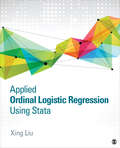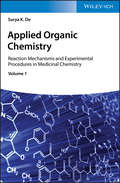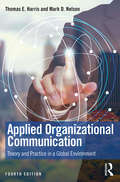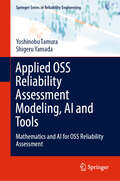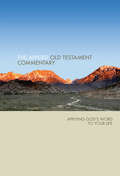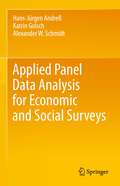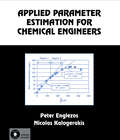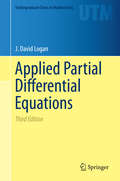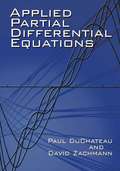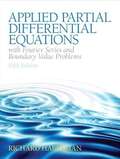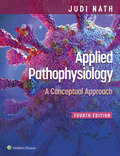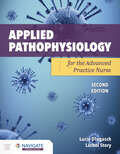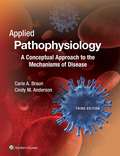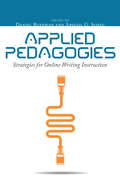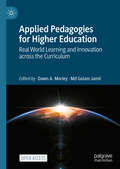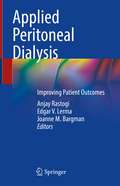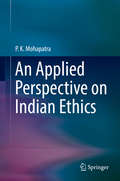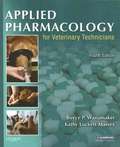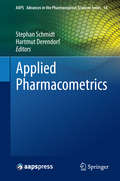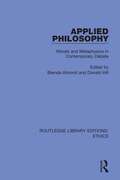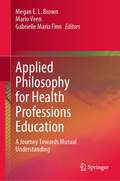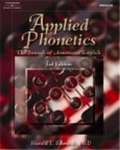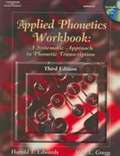- Table View
- List View
Applied Optimization Methods for Wireless Networks
by Y. Thomas Hou Yi Shi Hanif D. SheraliWritten in a unique style, this book is a valuable resource for faculty, graduate students, and researchers in the communications and networking area whose work interfaces with optimization. It teaches you how various optimization methods can be applied to solve complex problems in wireless networks. Each chapter reviews a specific optimization method and then demonstrates how to apply the theory in practice through a detailed case study taken from state-of-the-art research. You will learn various tips and step-by-step instructions for developing optimization models, reformulations, and transformations, particularly in the context of cross-layer optimization problems in wireless networks involving flow routing (network layer), scheduling (link layer), and power control (physical layer). Throughout, a combination of techniques from both operations research and computer science disciplines provides a holistic treatment of optimization methods and their applications. Each chapter includes homework exercises, with PowerPoint slides and a solutions manual for instructors available online.
Applied Ordinal Logistic Regression Using Stata: From Single-Level to Multilevel Modeling
by Xing LiuThe first book to provide a unified framework for both single-level and multilevel modeling of ordinal categorical data, Applied Ordinal Logistic Regression Using Stata helps readers learn how to conduct analyses, interpret the results from Stata output, and present those results in scholarly writing. Using step-by-step instructions, this non-technical, applied book leads students, applied researchers, and practitioners to a deeper understanding of statistical concepts by closely connecting the underlying theories of models with the application of real-world data using statistical software. An open-access website for the book contains data sets, Stata code, and answers to in-text questions.
Applied Ordinal Logistic Regression Using Stata: From Single-Level to Multilevel Modeling
by Xing LiuThe first book to provide a unified framework for both single-level and multilevel modeling of ordinal categorical data, Applied Ordinal Logistic Regression Using Stata helps readers learn how to conduct analyses, interpret the results from Stata output, and present those results in scholarly writing. Using step-by-step instructions, this non-technical, applied book leads students, applied researchers, and practitioners to a deeper understanding of statistical concepts by closely connecting the underlying theories of models with the application of real-world data using statistical software. An open-access website for the book contains data sets, Stata code, and answers to in-text questions.
Applied Organic Chemistry: Reaction Mechanisms and Experimental Procedures in Medicinal Chemistry
by Surya K. DeAn indispensable guide for all synthetic chemists who want to learn about the most relevant reactions and reagents employed to synthesize important heterocycles and drugs! The synthesis of natural products, bioactive compounds, pharmaceuticals, and drugs is of fundamental interest in modern organic chemistry. New reagents and reaction methods towards these molecules are being constantly developed. By understanding the mechanisms involved and scope and limitations of each reaction applied, organic chemists can further improve existing reaction protocols and develop novel efficient synthetic routes towards frequently used drugs, such as Aspirin or Penicillin. Applied Organic Chemistry provides a summary of important (name) reactions and reagents applied in modern organic chemistry and drug synthesis. It covers rearrangement, condensation, olefination, metathesis, aromatic electrophilic substitutions, Pd-catalyzed C-C bond forming reactions, multi-component reactions, as well as oxidations and reductions. Each chapter is clearly structured, providing valuable information on reaction details, step-by-step mechanism, experimental procedures, applications, and (patent) references. By providing mechanistic information and representative experimental procedures, this book is an indispensable guide for researchers and professionals in organic chemistry, natural product synthesis, pharmaceutical, and medicinal chemistry, as well as post-graduates preparing themselves for a job in the pharmaceutical industry. Hot Topic: Reviews important classes of organic reactions (incl. name reactions) and reagents in medicinal chemistry. Useful: Provides information on reaction details, common reagents, and functional group transformations used to synthesize natural products, bioactive compounds, drugs, and pharmaceuticals, e.g. Aspirin, Penicillin. Unique: For every reaction the mechanism is explained step by step, and representative experimental procedures are given, unlike most books in this area. User-friendly: Chapters are clearly structured making it easy for the reader to compare different reactions. Applied Organic Chemistry is an indispensable guide for researchers and professionals in organic chemistry, natural product synthesis, pharmaceutical, and medicinal chemistry, as well as post-graduates preparing themselves for a job in the pharmaceutical industry.
Applied Organizational Communication: Theory and Practice in a Global Environment (Routledge Communication Series)
by Mark D. Nelson Thomas E. HarrisApplied Organizational Communication provides a current, in-depth analysis of the theories and practices critical to understanding organizational communication concepts in a global environment. Building on the successful foundation of the previous editions, this fourth edition has been thoroughly updated and revised to reflect the most current organizational communication theory and research, and includes new information on the use of technology, incorporated throughout. Additional features of this text include: Extensive real-life examples that establish links between organizational communication and perceptions, theory, networks, and symbolic behaviour. Theory-based consulting approaches that enhance abilities to link issues with actions. Grounding in transactional communication and advanced systems approaches. Macro and micro analyses of key topics and issues. As an accessible and practical examination of organizational communication, this text is intended for use in organizational communication, leadership, organizational development, and organizational intervention courses at the advanced undergraduate and graduate level.
Applied OSS Reliability Assessment Modeling, AI and Tools: Mathematics and AI for OSS Reliability Assessment (Springer Series in Reliability Engineering)
by Shigeru Yamada Yoshinobu TamuraThis textbook introduces the theory and application of open source software (OSS) reliability. The measurement and management of open source software are essential to produce and maintain quality and reliable systems while using open source software. This book describes the latest methods for the reliability assessment of open source software. It presents the state of the art of open source software reliability measurement and assessment based on stochastic modeling and deep learning approaches. It introduces several stochastic reliability analyses of OSS computing with application along with actual OSS project data. The book contains exercises to aid learning and is useful for graduate students and researchers.
Applied OT Bible Commentary
by Tom Hale Steve ThorsonThe wisdom found in God's Word is timeless, as relevant today as when it was first written. And the challenge for believers remains unchanged: how do we apply these truths to our everyday world?The Applied Commentary series is a fresh approach to Bible study, connecting great wisdom with your life today. Each Scripture passage is enhanced with insights on key themes and ideas. Featured articles provide a deeper look at essential concepts, while the contemporary language allows for easy reading. And because some subjects are open to interpretation for discussion, we've included perspectives from leading theologians from all backgrounds and denominations. The result?An interactive approach to Scripture that will challenge your ideas and build your faith--which is what reading the Bible is all about.
Applied Panel Data Analysis for Economic and Social Surveys
by Katrin Golsch Hans-Jürgen Andreß Alexander W. SchmidtMany economic and social surveys are designed as panel studies, which provide important data for describing social changes and testing causal relations between social phenomena. This textbook shows how to manage, describe, and model these kinds of data. It presents models for continuous and categorical dependent variables, focusing either on the level of these variables at different points in time or on their change over time. It covers fixed and random effects models, models for change scores and event history models. All statistical methods are explained in an application-centered style using research examples from scholarly journals, which can be replicated by the reader through data provided on the accompanying website. As all models are compared to each other, it provides valuable assistance with choosing the right model in applied research. The textbook is directed at master and doctoral students as well as applied researchers in the social sciences, psychology, business administration and economics. Readers should be familiar with linear regression and have a good understanding of ordinary least squares estimation.
Applied Parameter Estimation for Chemical Engineers
by Peter Englezos Nicolas KalogerakisThis book determines adjustable parameters in mathematical models that describe steady state or dynamic systems, presenting the most important optimization methods used for parameter estimation. It focuses on the Gauss-Newton method and its modifications for systems and processes represented by algebraic or differential equation models.
Applied Partial Differential Equations (Undergraduate Texts in Mathematics #89)
by J. David LoganThis textbook is for the standard, one-semester, junior-senior course that often goes by the title "Elementary Partial Differential Equations" or "Boundary Value Problems". The audience consists of students in mathematics, engineering, and the sciences. The topics include derivations of some of the standard models of mathematical physics and methods for solving those equations on unbounded and bounded domains, and applications of PDE's to biology. The text differs from other texts in its brevity; yet it provides coverage of the main topics usually studied in the standard course, as well as an introduction to using computer algebra packages to solve and understand partial differential equations. For the 3rd edition the section on numerical methods has been considerably expanded to reflect their central role in PDE's. A treatment of the finite element method has been included and the code for numerical calculations is now written for MATLAB. Nonetheless the brevity of the text has been maintained. To further aid the reader in mastering the material and using the book, the clarity of the exercises has been improved, more routine exercises have been included, and the entire text has been visually reformatted to improve readability.
Applied Partial Differential Equations (Dover Books on Mathematics)
by David Zachmann Paul DuChateauSuperb introduction devotes almost half its pages to numerical methods for solving partial differential equations, while the heart of the book focuses on boundary-value and initial-boundary-value problems on spatially bounded and on unbounded domains; integral transforms; uniqueness and continuous dependence on data, first-order equations, and more. Numerous exercises included, with solutions for many at end of book. For students with little background in linear algebra, a useful appendix covers that subject briefly.
Applied Partial Differential Equations With Fourier Series and Boundary Value Problems
by Richard HabermanThis book emphasizes the physical interpretation of mathematical solutions and introduces applied mathematics while presenting differential equations. Coverage includes Fourier series, orthogonal functions, boundary value problems, Green’s functions, and transform methods. <p><p> This text is ideal for readers interested in science, engineering, and applied mathematics.
Applied Pathophysiology: A Conceptual Approach
by Judi Nath Carie BraunThoroughly updated and informed by the latest research-based evidence, Applied Pathophysiology: A Conceptual Approach, 4th Edition, employs a unique, body function framework to not only deliver the conceptual knowledge students need but also the critical thinking and clinical confidence to effectively apply their understanding to practice. This novel approach instills a deeper understanding of altered human function than traditional memorization, empowering students to achieve optimal client outcomes in the management of a wide range of diseases.
Applied Pathophysiology for the Advanced Practice Nurse
by Lucie Dlugasch Lachel StoryApplied Pathophysiology for the Advanced Practice Nurse, Second Edition is a comprehensive resource that serves as a bridge between clinical experience and the advanced knowledge necessary for the role of an APRN. It helps graduate students navigate the data and presentation of symptoms that must be considered when making a diagnosis and recommendation for treatment. This unique text includes expanded pathophysiology content across the life span and information to meet the needs of many advanced practice population areas, including pediatrics, psychiatric mental health, and gerontology. It also incorporates information from both an acute and primary care focus.
Applied Pathophysiology (Third Edition): A Conceptual Approach To The Mechanisms Of Disease
by Carie Braun Cindy AndersonEmphasizing application of knowledge, active learning strategies, critical thinking, and evidence-based practice, this updated 3rd Edition of Applied Pathophysiology: A Conceptual Approach to the Mechanisms of Disease explores pathophysiology through the lens of body function concepts and what happens when function is altered through injury or disease. <p><p> This novel approach helps students understand that diseases are rarely confined to one body system and challenges them to apply what they’ve learned to a range of diseases, rather than trying to memorize facts about specific conditions. In the process, they learn to think about pathophysiology in the same way practioners do in a clinical setting—by working from symptoms to the cause, rather than the other way around. <p> The 3rd Edition features much that is new including a new chapter on mental illnesses, new case studies in every chapter, and a wide range of new clinically-focused features.
Applied Pedagogies: Strategies for Online Writing Instruction
by Daniel Ruefman and Abigail G. SchegTeaching any subject in a digital venue must be more than simply an upload of the face-to-face classroom and requires more flexibility than the typical learning management system affords. Applied Pedagogies examines the pedagogical practices employed by successful writing instructors in digital classrooms at a variety of institutions and provides research-grounded approaches to online writing instruction. This is a practical text, providing ways to employ the best instructional strategies possible for today’s diverse and dynamic digital writing courses. Organized into three sections—Course Conceptualization and Support, Fostering Student Engagement, and MOOCs—chapters explore principles of rhetorically savvy writing crossed with examples of effective digital teaching contexts and genres of digital text. Contributors consider not only pedagogy but also the demographics of online students and the special constraints of the online environments for common writing assignments. The scope of online learning and its place within higher education is continually evolving. Applied Pedagogies offers tools for the online writing classrooms of today and anticipates the needs of students in digital contexts yet to come. This book is a valuable resource for established and emerging writing instructors as they continue to transition to the digital learning environment. Contributors: Kristine L. Blair, Jessie C. Borgman, Mary-Lynn Chambers, Katherine Ericsson, Chris Friend, Tamara Girardi, Heidi Skurat Harris, Kimberley M. Holloway, Angela Laflen, Leni Marshall, Sean Michael Morris, Danielle Nielsen, Dani Nier-Weber, Daniel Ruefman, Abigail G. Scheg, Jesse Stommel
Applied Pedagogies for Higher Education: Real World Learning and Innovation across the Curriculum
by Dawn A. Morley Md Golam JamilThis open access book critiques real world learning across both the curriculum and extracurricular activities. Drawing on disciplines as diverse as business, health, fashion, sociology and geography, the editors and authors employ a cross-disciplinary approach to examine how this concept is being applied in higher education. Divided into three parts, the authors and contributors analyse broader applications of real world learning, student experience of practicing in a real world setting, and how learning strategies can be employed to engage students in real world learning. The editors and contributors provide up-to-date, cross-disciplinary and international insights into how real world learning could be integrated into the higher education curriculum to support effective, relevant and life-long learning for 21st century students.
Applied Peritoneal Dialysis: Improving Patient Outcomes
by Edgar V. Lerma Anjay Rastogi Joanne M. BargmanThis book offers a comprehensive guide to peritoneal dialysis (PD). Home dialysis, and more specifically PD, is growing in popularity in the US. By conservative estimates, experts suggest that 45 percent of dialysis patients in the US can be on home dialysis. However, the current penetration rate is only 10 percent. This is changing with an expected major increase in the next 5 years. One of the reasons for the low uptake is that many nephrologists lack comfort and confidence in using PD as a dialysis modality. This book addresses those concerns by covering all aspects of PD. Chapters include its history, patient selection, implementation options, comorbidities, quality of life concerns, and developing approaches to treatment. This comprehensive resource fills the unmet need for a practical, hands-on book that is both detailed and can work as a quick reference. This is an ideal guide for academic nephrologists, private practice nephrologists, NPs, PAs, nurses, fellows, and residents.
An Applied Perspective on Indian Ethics
by P. K. MohapatraThis book presents a novel interpretation of major problems of Indian ethics from an applied ethical perspective. It approaches prominent theories like Dharma, Karma and Purusarthas from a critical point of view, so as to render them logically consistent and free from some standard limitations. Ethical theories are meant to provide guidance for life, but quite often many of our celebrated theories appear to be inapplicable or difficult to apply in practical life. Indian ethical theories are of special significance to this problem because they have in them rich potentials of applicability as much as many of them typify inapplicable abstract theories of morals. The book incorporates a wealth of research on ethical theories, keeping in view the spirit of ethics and the demands of the situations; for a reasoned balance between the two is the key to applied ethics. The book argues that ethical theories are objective but defeasible in overriding circumstances where competing values deserve preference. Such justified exceptions are warranted by the very spirit of ethics, which is to promote the good life. The argument from defeasibility and justified violation in the book helps bridging the gap between ethics and its application and makes Indian theories of value appear in fresh light- workable, practically applicable and effective as incentives for morality. With uncommon virtue of contemporized presentation of Indian ethics, this book should be of interest to scholars and researchers working on Indian ethics and moral philosophy, as well as to those interested in Indian culture and value tradition.
Applied Pharmacology for Veterinary Technicians (4th Edition)
by Boyce P. Wanamaker Kathy Lockett MasseyDesigned specifically for veterinary technicians, this essential resource offers detailed guidance on key topics such as managing medication inventory, dispensing veterinarian prescribed drugs, calculating drug dosages, administering medications to animals, and educating clients about drug side effects and precautions. Up-to-date drug information is presented in a consistent, easy-to-use format that includes pharmacokinetics, pharmacodynamics, clinical uses, dosage forms, and adverse side effects. Illustrated, step-by-step procedures demonstrate proper administration techniques for common drug forms. Learning Objectives at the beginning of each chapter help you focus your study efforts and check your progress as you work through the material. Chapter outlines provide at-a-glance overviews of the topics featured in each chapter, making it quick and easy to find information. Key Terms lists with definitions familiarize you with the terminology used in each chapter. Technicians Notes boxes throughout the book provide useful hints and important reminders to help you avoid common errors and increase your efficiency. Coverage of inventory control offers practical tips on performing this important task, including understanding the different vendor types, communicating with sales representatives, and using veterinary practice management computer software. Detailed summaries of important drug laws, such as the Animal Medicinal Drug Use Clarification Act and the Animal Drug Availability Act, introduce you to the legal and ethical aspects of veterinary pharmacology. The companion CD-ROM contains a handy drug dosage calculator and photographs of drug labels to familiarize you with the drug information youll encounter in practice. Proprietary drug names are listed along with generic names to help you learn to recognize drugs with generic options. Additional review questions in this edition help reinforce your understanding of key concepts. Answers are located in the back of the book so you can check the accuracy of your responses. The chapter on Drugs Used in Skin Disorders offers expanded coverage of the anatomy and physiology of the skin, as well as the latest drugs used to treat skin disorders.
Applied Pharmacometrics (AAPS Advances in the Pharmaceutical Sciences Series #14)
by Hartmut Derendorf Stephan SchmidtThis comprehensive volume provides an update on the current state of pharmacometrics in drug development. It consists of nineteen chapters all written by leading scientists from the pharmaceutical industry, regulatory agencies and academia. After an introduction of the basic pharmacokinetic and pharmacodynamic concepts of pharmacometrics in drug development, the book presents numerous examples of specific applications that utilize pharmacometrics with modeling and simulations over a variety of therapeutic areas, including pediatrics, diabetes, obesity, infections, psychiatrics, Alzheimer's disease, and dermatology, among others. The examples illustrate how results from all phases of drug development can be integrated in a more timely and cost-effective process. Applying pharmacometric decision tools during drug development can allow objective, data-based decision making. At the same time, the process can identify redundant or unnecessary experiments as well as some costly clinical trials that can be avoided. In addition to cost saving by expedited development of successful drug candidates, pharmacometrics has an important economic impact in drug product selection. Unsuccessful drug candidates can be identified early and discontinued without expending efforts required for additional studies and allocating limited resources. Hence, pharmacometric modeling and simulation has become a powerful tool to bring new and better medications to the patient at a faster pace and with greater probability of success.
Applied Philosophy: Morals and Metaphysics in Contemporary Debate
by Brenda Almond Donald HillIn bringing the concepts and methods of philosophy to bear on specific, pressing, practical concerns, applied philosophy is the modern expression of a perennial concern: to understand, in part to control, and to come to terms with the conditions in which human life is to be lived. Originally published in 1991 and written by distinguished philosophers and academics from Europe, the USA and Australia, the essays collected in this volume examine subjects of continued concern and debate, such as the environment, personal relationships, terrorism and medicine. The contributions were originally published in the Journal of Applied Philosophy.
Applied Philosophy for Health Professions Education: A Journey Towards Mutual Understanding
by Megan E. L. Brown Mario Veen Gabrielle Maria FinnThis book increases the accessibility of philosophical concepts to a wider audience within medical education, translating ‘knowing’ to ‘doing.’ It prompts health professions educators and researchers to consider the dynamics and structure of contemporary issues within health professions education in new, philosophical ways. Through considering the practical implications of applying philosophical concepts to contemporary issues, the book recommends avenues for further research and pedagogical change. Individual educators are considered, with practice points for teaching generated within each chapter. Readers will acquire practical ways in which they can change their own practice or pedagogy that align with the new insight offered through our philosophical analysis. These practical recommendations may be systemic in nature, but the authors of this book also offer micro-level recommendations for practitioners that can be considered as ways to improve individual approaches to education and research.
Applied Phonetics: The Sounds of American English (3rd edition)
by Harold T. EdwardsFor the third edition Edwards (communicative disorders and sciences, Wichita State U., Wichita, Kansas) has expanded the sections on dynamics of speech, American English dialects, and speech mechanism. As in earlier editions, the volume teaches the student to transcribe in the first part. The second part, which can be used as a reference work, contains an exhaustive resource for each of the sounds of American English. Annotation (c)2003 Book News, Inc., Portland, OR (booknews.com)
Applied Phonetics Workbook: A Systematic Approach to Phonetic Transcription (3rd edition)
by Harold T. Edwards Alvin L. GreggBecoming proficient in phonetics takes practice, practice, and more practice. The Applied Phonetics Workbook provides just the resources to allow you to practice and hone your transcription skills. Exercises begin at a very basic level and build as your skills improve and develop.

